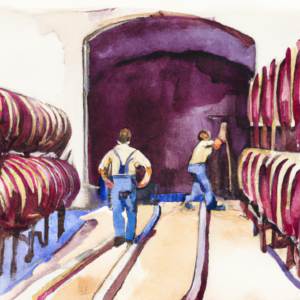During the winemaking process, yeast and other particles in the wine settle at the bottom of the container as sediment. Racking is the process of carefully transferring the clear wine from the top of the container into another container, leaving the sediment behind.
When people make wine, things like yeast and bits from the grapes can sink to the bottom and make it cloudy. Racking is when they carefully take the clear wine from the top and move it to a different container, leaving the cloudy

bits behind. Racking makes the wine clearer and brighter and can help prevent it from spoiling.
There are a few different ways to rack wine. One way is to let gravity move the wine from one container to another. This is gentle but takes a long time. Another way is to use a pump to move the wine more quickly, but this can be rough and damage the wine. Some winemakers use a combination of both methods.
Racking is important, but it can also be tricky. If they rack too much or at the wrong time, the wine can lose its taste and smell. If they don’t rack enough, the wine might be cloudy or unstable. Sometimes winemakers also use other ways to make their wine clearer and more stable, like adding special substances or passing it through a filter.
The decision to rack a wine and how often to do it depends on a few things, like what kind of wine they’re making and what they want it to taste and look like. With careful attention and skill, racking can help make high-quality, clear, and stable wines.
The average lifespan of a grapevine is about 30-35 years, although some vines can live for over 100 years.
Tags, Tags, #hashtags, Tags